Gezer
Gezer, or Tel Gezer (Hebrew: גֶּזֶר), in Arabic: تل الجزر – Tell Jezar or Tell el-Jezari, the site of the abandoned Arab village of Abu Shusheh, is an archaeological site in the foothills of the Judaean Mountains at the border of the Shfela region roughly midway between Jerusalem and Tel Aviv. It is now an Israeli national park. In the Hebrew Bible, Gezer is associated with Joshua and Solomon.
גֶּזֶר | |
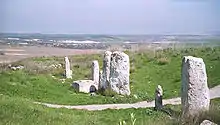 The Gezer High Place with massebot and basin | |
 Shown within Israel | |
| Alternative name | Tel Gezer (Heb.), Tell Jezer/Tell el-Jazari (Ar.) |
|---|---|
| Location | |
| Coordinates | 31°51′32.4″N 34°55′8.4″E |
| Site notes | |
| Condition | Ruin |
It became a major fortified Canaanite city-state in the first half of the 2nd millennium BCE. It was later destroyed by fire and rebuilt. The Amarna letters mention kings of Gezer swearing loyalty to the Egyptian pharaoh.[1] Its importance was due in part to the strategic position it held at the crossroads of the ancient coastal trade route linking Egypt with Syria, Anatolia and Mesopotamia, and the road to Jerusalem and Jericho, both important trade routes.
Name
Hellenistic and Roman period
Josephus writes that a certain "Gadara" was one of the five synedria, or regional administrative capitals of the Hasmonean realm, established by the Roman proconsul of Syria, Gabinius, in 57 BCE.[2] The name has been edited to "Gazara" in the Loeb edition, in accordance with an identification of Gadara with Gezer. However, other researchers prefer one of two candidates from Transjordan, Gadara in Perea, or Gadara of the Decapolis (see more at Perea and Gadara (disambiguation)).
Location
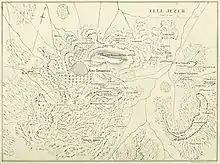
Gezer was located on the northern fringe of the Shephelah region, approximately thirty kilometres northwest of Jerusalem. It was strategically situated at the junction of the Via Maris, the international coastal highway, and the highway connecting it with Jerusalem through the valley of Ayalon, or Ajalon.
Verification of the identification of this site with biblical Gezer comes from bilingual inscriptions in either Hebrew or Aramaic, and Greek, found engraved on rocks several hundred meters from the tell. These inscriptions from the 1st century BCE read "boundary of Gezer" and "of Alkios" (probably the governor of Gezer at the time).
In the Hebrew Bible
Conquest under Joshua
The biblical story of the Israelite conquest of Canaan under their leader Joshua mentions a certain "king of Gezer" (Joshua 10:33) who had gone to help his countrymen in Lachish, where he met his death.
Gezer is listed in the Book of Joshua as a Levitical city, one of ten allotted to the Levite children of Kehoth - the Kohathites (Joshua, ch. 21).
The sack of Gezer
| Siege of Gezer | |||||||
|---|---|---|---|---|---|---|---|
| |||||||
| Belligerents | |||||||
| Egypt | Philistines | ||||||
| Commanders and leaders | |||||||
| Siamun (?) | Unknown | ||||||
| Strength | |||||||
| Unknown | Unknown | ||||||
| Casualties and losses | |||||||
| Unknown | Many killed | ||||||
According to the Hebrew Bible, the only source for both the existence of Solomon and this particular event, the Sack of Gezer took place at the beginning of the 10th century BCE, when the city was conquered and burned by an unnamed Egyptian pharaoh, identified by some with Siamun, during his military campaign in Palestine. This anonymous Egyptian pharaoh then gave it to King Solomon as the dowry of his daughter. Solomon then rebuilt Gezer and fortified it.
The Bible states:
.... King Solomon .... build .... the wall of .... Gezer (Pharaoh king of Egypt had gone up and captured Gezer and burned it with fire, and had killed the Canaanites who lived in the city, and had given it as dowry to his daughter, Solomon's wife;
— (1 Kings 9:15-16)
Identifying the pharaoh
The only mention in the Bible of a pharaoh who might be Siamun (ruled 986–967 BC) is the text from 1 Kings quoted above, and we have no other historical sources that clearly identify what really happened. As shown below, Kenneth Kitchen believes that Siamun conquered Gezer and gave it to Solomon. Others such as Paul S. Ash and Mark W. Chavalas disagree, and in 2001 Chavalas states that "it is impossible to conclude which Egyptian monarch ruled concurrently with David and Solomon".[3] Professor Edward Lipinski argues that Gezer, then unfortified, was destroyed late in the 10th century (and thus not contemporary with Solomon) and that the most likely Pharaoh was Shoshenq I (ruled 943–922 BC). "The attempt at relating the destruction of Gezer to the hypothetical relationship between Siamun and Solomon cannot be justified factually, since Siamun's death precedes Solomon's accession."[4]
Tanis temple relief
One fragmentary but well-known surviving triumphal relief scene from the Temple of Amun at Tanis believed to be related to the sack of Gezer depicts an Egyptian pharaoh smiting his enemies with a mace. According to the Egyptologist Kenneth Kitchen, this pharaoh is Siamun.[5]:p. 109 The pharaoh appears here "in typical pose brandishing a mace to strike down prisoners(?) now lost at the right except for two arms and hands, one of which grasps a remarkable double-bladed axe by its socket."[5]:pp. 109 and 526 The writer observes that this double-bladed axe or 'halberd' has a flared crescent-shaped blade which is close in form to the Aegean-influenced double axe but is quite distinct from the Canaanite double-headed axe, which has a different shape that resembles an X.[5]:pp. 109–10 Thus, Kitchen concludes Siamun's foes were the Philistines who were descendants of the Aegean-based Sea Peoples and that Siamun was commemorating his recent victory over them at Gezer by depicting himself in a formal battle scene relief at the temple in Tanis. More recently Paul S. Ash has put forward a detailed argument that Siamun's relief portrays a fictitious battle. He points out that in Egyptian reliefs Philistines are never shown holding an axe, and that there is no archaeological evidence for Philistines using axes. He also argues that there is nothing in the relief to connect it with Philistia or the Levant.[6]
History of excavation
Archaeological excavation at Gezer has been going on since the early 1900s, and it has become one of the most excavated sites in Israel. The site was identified with ancient Gezer by Charles Simon Clermont-Ganneau in 1871. R. A. Stewart Macalister excavated the site between 1902 and 1909 on behalf of the Palestine Exploration Fund. Macalister recovered several artifacts and discovered several constructions and defenses. He also established Gezer's habitation strata, though due to poor stratigraphical methods, these were later found to be mostly incorrect (as well as many of his theories). Other notable archaeological expeditions to the site were made by Alan Rowe (1934), G.E. Wright, William Dever and Joe Seger between 1964 and 1974 on behalf of the Nelson Glueck School of Archaeology in the Hebrew Union College, again by Dever in 1984 and 1990, as well as the Andrews University.[7]
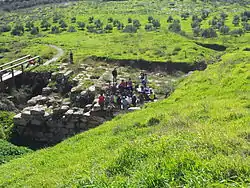
Excavations were renewed in June 2006 by a consortium of institutions under the direction of Steve Ortiz of the Southwestern Baptist Theological Seminary (SWBTS) and Sam Wolff of the Israel Antiquities Authority (IAA). The Tel Gezer Excavation and Publication Project is a multi-disciplinary field project investigating the Iron Age history of Gezer.
The first season of the Gezer excavations concluded successfully and revealed some interesting details. Among other things is a discovery of A thick destruction layer may be dated to the destruction at the hands of the Egyptians, which some associate with the biblical episode from 1 Kings 9:16.{{“(Pharaoh, the king of Egypt, had attacked and captured Gezer, killing the Canaanite population and burning it down. He gave the city to his daughter as a wedding gift when she married Solomon.” 1 Kings 9:16 NLT|date=November 2020}}
In 2013, two separate archaeological survey-excavations were conducted at Tel Gezer, the one by Tsvika Tsuk, Yohanan Hagai, and Daniel Warner, on behalf of the IAA,[8] and the other led by a team of archaeologists from the SWBTS and Andrews University's Institute of Archaeology.[9]
History and archaeology
Chalcolithic
The first settlement established at Tel Gezer dates to the end of the 4th millennium BCE during the Chalcolithic period, when large caves cut into the rock were used as dwellings.[10]
Bronze Age
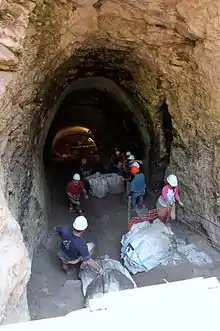
Early Bronze Age
At the beginning of the Early Bronze Age (early 3rd millennium BCE), an unfortified settlement covered the tell. It was destroyed in the middle of the 3rd millennium BCE and subsequently abandoned for several centuries.[11][10]
Middle Bronze Age
In the Middle Bronze Age IIB (MBIIB, first half of the 2nd millennium BCE), Gezer became a major city, well fortified[11] and containing a large cultic site.[12] It may have grown due to MBIIA-sites like Aphek becoming weaker.
- Fortifications
The fortifications consisted of two lines of defense surrounding the tell.[10] First, an outer earthen rampart c. 5 metres high, built of compacted alternating layers of chalk and earth covered with plaster.[10] Second, a 4 metre wide inner wall made of large stone blocks, reinforced with towers.[10] The city gate stood near the southwest corner of the wall, was flanked by two towers which protected the wooden doors, a common design for its time.[10] The tell was surrounded by a massive stone wall and towers, protected by a five-meter-high (16 ft) earthen rampart covered with plaster. The wooden city gate, near the southwestern corner of the wall, was fortified by two towers.[11]
- Cultic site with massebot
Cultic remains discovered in the northern part of the tell were a row of ten large standing stones, known as massebot or matsevot, singular masseba/matseva, oriented north–south, the tallest of which was three meters high, with an altar-type structure in the middle, and a large, square, stone basin, probably used for cultic libations. The exact purpose of these megaliths is still debated, but they may have constituted a Canaanite "high place" from the Middle Bronze Age, ca. 1600 BCE, each masseba possibly representing a Canaanite city connected to Gezer by treaties enforced by rituals performed here. Both the number and size of the standing stones confer a unique character to this cultic site.[12] Such massebot are found elsewhere in the country, but those from Gezer massebot are the most impressive examples.[13][10][14][15] A double cave beneath the high place was shown to be predating it and not connected to it.
Late Bronze Age
| ḳꜣḏjr or ḳꜣḏꜣꜣr[16][17] in hieroglyphs |
|---|
The Canaanite city was destroyed in a fire, presumably in the wake of a campaign by the Egyptian pharaoh Thutmose III (ruled 1479–1425 BC). The oldest known historical reference to the city is to be found on an inscription of conquered sites at Thutmose's temple at Karnak.[16][7] A destruction layer from this event was found in all excavated areas of the tell.[10]
The Tell Amarna letters, dating from the 14th century BCE, include ten letters from the kings of Gezer swearing loyalty to the Egyptian pharaoh. The city-state of Gezer (named Gazru in Babylonian) was ruled by four leaders during the 20-year period covered by the Amarna letters.[11] Discoveries of several pottery vessels, a cache of cylinder seals and a large scarab with the cartouche of Egyptian pharaoh Amenhotep III attest to the existence of a city at Gezer's location in the 14th century BCE - one that was apparently destroyed in the next century[18] - and suggest that the city was inhabited by Canaanites with strong ties to Egypt.[19]
In the Late Bronze Age (second half of the 2nd millennium BCE) a new city wall, four meters thick, was erected outside the earlier one.[10] It is a very rare example of Late Bronze Age fortifications in the country, witness for the elevated political status of Gezer in southern Canaan during Egyptian rule.[10]
In the 14th century BCE, a palace was constructed on the high western part of the tell, the city's acropolis.[10] Archaeologists also discovered remains of what might have been the Egyptian governor's residence from the same period in the northern part of the tell.[10]
Toward the end of the Bronze Age, the city declined and its population diminished.[10] Gezer is mentioned in the victory stele of Merneptah, dating from the end of the 13th century BCE.[10]
Iron Age

In 12th-11th centuries BCE, a large building with many rooms and courtyards was situated on the acropolis. Grinding stones and grains of wheat found among the sherds indicate that it was a granary. Local and Philistine vessels attest to a mixed Canaanite/Philistine population.
Tiglath-Pileser III and the Neo-Assyrian period
The Neo-Assyrian king Tiglath-Pileser III put Gezer under siege between the years 734 and 732 BC.[20] The city was probably captured by the Assyrians at the end of the campaign of Tiglath-Pileser III to Canaan. A reference to Gezer may have appeared in a cuneiform relief from the 8th-century BCE royal palace of Tiglath-Pileser III at Nimrud.[7] The siege may have been the one depicted on a stone relief at the royal palace in Nimrud, where the city was called 'Gazru'.
Hellenistic period
During the Hellenistic period, Gezer was fortified by the Maccabees and was ruled by the independent Jewish Hasmonean dynasty (Maccabees 1 13:43-48).
Post-Hellenistic periods
Gezer was sparsely populated during Roman times and later times, as other regional population centers took its place.[1]
Crusader period
In 1177, the plains around Gezer were the site of the Battle of Montgisard, in which the Crusaders under Baldwin IV defeated the forces of Saladin. There was a Crusader Lordship of Montgisard and apparently a castle stood there, a short distance from Ramleh.[21]
Ottoman and modern periods
Selected archaeological findings
In July 2017, archaeologists discovered skeletal remains of a family of three, one of the adults and a child wearing earrings, believed to have been killed during an Egyptian invasion in the 13th-century BCE.[22][23] A 13th century BCE amulet, various scarabs and cylinder seals were also found on the site. The amulet bears the cartouches —or official royal monikers— of the Egyptian Pharaohs Thutmose III and Ramses II.[18]
Canaanite water system

A large Canaanite (Bronze Age) water system comprising a tunnel going down to a spring, similar to those found in Jerusalem, Hazor and Megiddo, was first excavated by Macalister and was re-excavated as part of the 2006-17 campaigns of the Tel Gezer Excavation and Publication Project.[23]
"Gezer calendar"
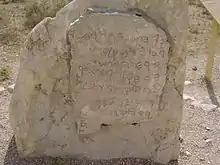
One of the best-known finds is the Gezer calendar. This is a plaque containing a text appearing to be either a schoolboy's memory exercises, or something designated for the collection of taxes from farmers. Another possibility is that the text was a popular folk song, or child's song, listing the months of the year according to the agricultural seasons. It has proved to be of value by informing modern researchers of ancient Middle Eastern script and language, as well as the agricultural seasons.
Israelite city gate, wall
In 1957 Yigael Yadin identified a wall and six-chambered gateway very similar in construction to remains excavated at Megiddo and Hazor as Solomonic;[24] they have since been reinterpreted by some as dating from several centuries later.
Boundary stones
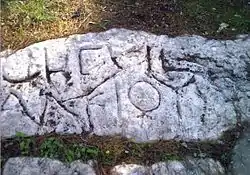
Thirteen boundary stones have been identified near the tell, distanced between less than 200 metres to almost 2 km from it, probably dating from the Late Hellenistic period (late second[25] - first century BCE), the most recent having been found by archaeologists from SWBTS in 2012.[26] See also Location.
There are only a few "lost" biblical cities that have been positively identified through inscriptions discovered by means of archaeological work (surveys or digs).[26] Gezer is the first among them thanks to Clermont-Ganneau's discovery of three such inscribed stones in 1874 and of a fourth in 1881.[26]
Ten of the thirteen inscriptions are bilingual,[27] including the first three ones, containing two distinct parts, one in Greek and one either Hebrew or Aramaic,[27] and written in what is known as square Hebrew characters.[26] Clermont-Ganneau's reading of the Hebrew/Aramaic part as "the boundary of Gezer" was later confirmed.[26] The inscriptions' Greek part contains personal names, either (H)alkios, Alexas, or Archelaos, for instance Clermont-Ganneau's four stones were all bearing the inscription "of Alkios".[26] Sometimes the two parts are upside-down, or "tête-bêche", in relation to each other,[26] on the last discovered one the lines being separated by a line and the Hebrew/Aramaic inscription "Tehum Gezer" ("the boundary of Gezer")[25] facing the tell.[26] With the discovery of the last nine inscriptions it became evident that their distribution does not support Clermont-Ganneau's initial interpretation, of them marking Gezer's Sabbath limit, but rather that they probably mark the boundaries between private estates, or between city land and these estates.[26] Analysis of the lettering have led to the conclusion that they were all contemporaneous, with opinions based on palaeography and history slightly diverging in regard to their date - either Hasmonean or Herodian.[26] The earlier date and the Hebrew script can be connected to what we know from the First Book of Maccabees about Simon replacing the gentile inhabitants with Jewish ones (1 Macc. 13:47-48) The later date can be supported by a scenario in which Herod, after acquiring the lands of the vanquished Hasmoneans, gave them to (H)alkios, Archelaos and Alexas, all three names mentioned by Josephus for members of a powerful land-owning family from Herod's court.[26]
Language: Hebrew or Aramaic
According to David M. Jacobson, who states that the inscriptions are in Hebrew, this is an interesting fact, considering that Aramaic was the common administrative language in Judaea by the late Second Temple period.[26]
Other scholars are not convinced that the language of the inscriptions is indeed Hebrew, not Aramaic, leaving both options as possible, as is the case in the Corpus Inscriptionum Iudaeae/Palaestinae.[27]
See also
References
- James F. Ross (May 1967). "Gezer in the Tell el-Amarna Letters". The Biblical Archaeologist. Jstor.org. 30 (2): 62–70. doi:10.2307/3210955. JSTOR 3210955. S2CID 165347088.
- Meyers, Eric M. (1999). Meyers, Eric M. (ed.). Sepphoris on the Eve of the Great Revolt. Papers of the 2nd International Conference on Galilee in Antiquity, 1997, Duke University. Galilee Through the Centuries: Confluence of Cultures. Duke Judaic studies, volume 1. Eisenbrauns. p. 113. ISBN 9781575060408. Retrieved 30 May 2020.
- Chavalas, Mark W.; Ash, Paul S. (Spring 2001). "Review of David, Solomon and Egypt: A Reassessment by Paul S. Ash". Journal of Biblical Literature. 120 (1): 152. doi:10.2307/3268603. JSTOR 3268603.
- Lipinski, Edward (2006). On the Skirts of Canaan in the Iron Age (Orientalia Lovaniensia Analecta). Leuven, Belgium: Peeters. pp. 96–97. ISBN 978-90-429-1798-9.
- Kitchen, K.A. (2003). On the Reliability of the Old Testament'. William B. Eerdmans Publishing.
- Ash, Paul S. (November 1999). David, Solomon and Egypt: A Reassessment (JSOT Supplement). Sheffield Academic Press. pp. 38–46. ISBN 978-1-84127-021-0.
- Laughlin, John Charles Hugh (2006). "Gezer - Did Solomon Build a City Gate Here?". Fifty Major Cities of the Bible: From Dan To Beersheba. Routledge. pp. 127–131. ISBN 9780415223157.
- Israel Antiquities Authority, Excavators and Excavations Permit for Year 2013, Survey Permit # A-6744
- Israel Antiquities Authority, Excavators and Excavations Permit for Year 2013, Survey Permit # S-438
- "Gezer - A Canaanite City and Royal Solomonic City". Israeli Ministry of Foreign Affairs. 26 Nov 2003. Retrieved 30 May 2020.
- "Gezer - Jewish Virtual Library". Webcache.googleusercontent.com. Archived from the original on 18 May 2015. Retrieved 2 January 2015.CS1 maint: bot: original URL status unknown (link)
- "Gezer – Ancient Importance to Israel". Allaboutarchaeology.org. Archived from the original on 8 February 2015. Retrieved 2 January 2015.
- Ussishkin, David (2006). Czerny E.; Hein I.; Hunger H.; Melman D.; Schwab A. (eds.). On the History of the High Place at Gezer. Studies in Honour of Manfred Bietak. II. Leuven: Peeters Publishers. pp. 411–416. Retrieved 30 May 2015.
- "Gilat". The Nelson Glueck School of Biblical Archaeology. Retrieved 2 June 2020.
- "The standing stone or stele". Netours.com. Archived from the original on 21 February 2015. Retrieved 2 January 2015.
- Gauthier, Henri (1928). Dictionnaire des Noms Géographiques Contenus dans les Textes Hiéroglyphiques Vol. 5. p. 164.
- Wallis Budge, E. A. (1920). An Egyptian hieroglyphic dictionary: with an index of English words, king list and geological list with indexes, list of hieroglyphic characters, coptic and semitic alphabets, etc. Vol II. John Murray. p. 1043.
- Philippe Bohstrom (2 July 2017). "First Discovery of Bodies in Biblical Gezer, From Fiery Destruction 3,200 Years Ago". Haaretz. Retrieved 30 May 2020.
- Shapira, Ran (2013-10-24). "Hidden secret of Gezer: A pre-Solomonic city beneath the ruins". Haaretz. Archived from the original on 2013-11-27. Retrieved 2013-11-27.CS1 maint: bot: original URL status unknown (link), Haaretz, published October 24, 2013, retrieved November 27, 2013.
- Ehrlich, Carl S. (November 1996). The Philistines in Transition: A History from Ca. 1000-730 B.C.E. Brill Academic Publishers. pp. 192–193. ISBN 978-90-04-10426-6.
- Bradbury, Jim (2004). Montgisard, Battle of, 25 November 1177. The Routledge Companion to Medieval Warfare. Routledge. ISBN 9781134598465. Retrieved 15 December 2017.
- Paton, C. (5 July 2017). "Israel: Ancient Human Remains Discovered in Biblical City 3,200 Years After its Destruction by the Egyptians". Newsweek. Retrieved 7 July 2017.
- Amanda Borschel-Dan (19 July 2017). "Biblical account of Gezer's destruction gains ground with torched skeleton finds". Times of Israel. Retrieved 30 May 2020.
- "Gezer". Encyclopædia Britannica. Retrieved 2 January 2015.
- Rosenberg, Stephen Gabriel (28 June 2012). "Boundary Stone at Gezer (Report from Jerusalem #43)" (PDF). Strata: Bulletin of the Anglo-Israel Archaeolocial Society (AIAS), Volume 30. London: 197-8. ISSN 2042-7867. Retrieved 1 June 2020.
- Jacobson, David M. (2015). "Editorial: The Gezer Boundary Inscriptions". Palestine Exploration Quarterly. 147 (2): 83–85. doi:10.1179/0031032815Z.000000000133. S2CID 161134724.
- Kaye, Noah (2018). Inscriptions of public character and in architectural context. 2746.-2776. The boundary stones from Tel Gezer. Corpus Inscriptionum Iudaeae/Palaestinae. Volume IV: Iudaea/Idumaea: 2649-3324. Walter de Gruyter. pp. 199–215. ISBN 978-3-11-054421-3. Retrieved 1 June 2020.
Further reading
- William G. Dever, Gezer Revisited: New Excavations of the Solomonic and Assyrian Period Defenses, The Biblical Archaeologist, Vol. 47, No. 4 (Dec., 1984), pp. 206–218
- Dever, William G., "Visiting the Real Gezer: A Reply to Israel Finkelstein", Journal of the Institute of Archaeology of Tel Aviv University, Volume 30, Number 2, September 2003, pp. 259–282(24)
- "Confronting the Past: Archaeological and Historical Essays on Ancient Israel", Seymour Gitin, (ed), Eisenbrauns, (January 2006), ISBN 978-1-57506-117-7
- Macalister, R. A. Stewart (1912). The Excavation of Gezer: 1902 - 1905 and 1907 - 1909 (PDF). John Murray, Albemarle Street West, London.
External links
| Wikimedia Commons has media related to Gezer. |